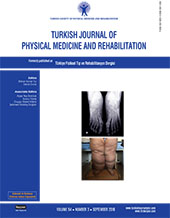Pain evaluation in a sample of Turkish children with cerebral palsy and its association with dependency level, verbal abilities, and the quality of life of patients and sociodemographic status, depression, and quality of life of their caregivers
2 Marmara University School of Medicine, (Student), İstanbul, Turkey DOI : 10.5606/tftrd.2018.1871 Objectives: This study aims to evaluate pain in children with cerebral palsy (CP), to investigate its association with dependency level, verbal abilities, and the quality of life (QoL) of children and sociodemographic status, depression levels, and QoL of their caregivers.
Patients and methods: Between February 2016 and April 2016, a total of 85 children (56 males, 29 females; mean age 7.1±2.5 years; range, 4 to 12 years) with CP were included. Their sociodemographic data, gross motor functional levels, verbal abilities (verbal and nonverbal) were evaluated. The children were categorized as independent (Gross Motor Function Classification System [GMFCS] 1), partially dependent (GMFCS 2,3), and totally dependent (GMFCS 4,5). The Non-Communicating Children`s Pain Checklist - Revised (NCCPC-R), the Caregiver Priorities & Child Health Index of Life with Disabilities (CPCHILD), the Nottingham Health Profile (NHP), and the Beck Depression Inventory (BDI) were used for the evaluation.
Results: A total of 50 (58.8%) of the children were verbal, while 35 (41.2%) were non-verbal. Of the patients, 47.1% were totally dependent, 37.6% were partially dependent, and 15.3% were independent. Pain was less frequent in the independent group, compared to the partially and totally dependent groups (p=0.04; p=0.013). There were no statistically significant difference in perceived pain according to the CPCHILD and NCCPC-R scores, when low and high socioeconomic status were compared (p>0.05). The QoL scores of children who were totally dependent and non-verbal were statistically significantly lower than those of the other children (p=0.0001, p=0.0001). A statistically significantly negative correlation between increased totally dependent children`s QoL scores and decreased QoL scores of the caregivers was observed (r=-0.429 p=0.006). The children with pain had a decreased QoL (p=0.03). The QoL of caregivers decreased and the depression scores of caregivers increased, as the pain scores of the children increased (r=0.291, p=0.007; r=-0.455, p=0.0001).
Conclusion: Our study results show that pain is more frequent in children with CP who are dependent and non-verbal, and it negatively affects the QoL of both caregivers and children. Evaluation of pain and the identification of CP patients who are at high risk of experiencing pain is worthwhile, as these individuals have difficulty in verbalizing pain due to their cognitive problems, although they are at risk of experiencing pain due to chronic physical problems, such as spasticity and contracture, as well as interventions for complicated medical problems.
Keywords : Caregivers; cerebral palsy; depression; pain; quality of life

















